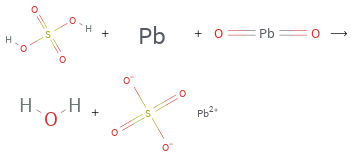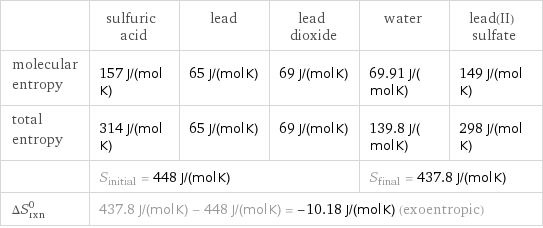Input interpretation

sulfuric acid + lead + lead dioxide ⟶ water + lead(II) sulfate
Balanced equation

Balance the chemical equation algebraically: + + ⟶ + Add stoichiometric coefficients, c_i, to the reactants and products: c_1 + c_2 + c_3 ⟶ c_4 + c_5 Set the number of atoms in the reactants equal to the number of atoms in the products for H, O, S and Pb: H: | 2 c_1 = 2 c_4 O: | 4 c_1 + 2 c_3 = c_4 + 4 c_5 S: | c_1 = c_5 Pb: | c_2 + c_3 = c_5 Since the coefficients are relative quantities and underdetermined, choose a coefficient to set arbitrarily. To keep the coefficients small, the arbitrary value is ordinarily one. For instance, set c_2 = 1 and solve the system of equations for the remaining coefficients: c_1 = 2 c_2 = 1 c_3 = 1 c_4 = 2 c_5 = 2 Substitute the coefficients into the chemical reaction to obtain the balanced equation: Answer: | | 2 + + ⟶ 2 + 2
Structures

+ + ⟶ +
Names

sulfuric acid + lead + lead dioxide ⟶ water + lead(II) sulfate
Reaction thermodynamics
Enthalpy

| sulfuric acid | lead | lead dioxide | water | lead(II) sulfate molecular enthalpy | -814 kJ/mol | 0 kJ/mol | -277.4 kJ/mol | -285.8 kJ/mol | -920 kJ/mol total enthalpy | -1628 kJ/mol | 0 kJ/mol | -277.4 kJ/mol | -571.7 kJ/mol | -1840 kJ/mol | H_initial = -1905 kJ/mol | | | H_final = -2412 kJ/mol | ΔH_rxn^0 | -2412 kJ/mol - -1905 kJ/mol = -506.3 kJ/mol (exothermic) | | | |
Entropy

| sulfuric acid | lead | lead dioxide | water | lead(II) sulfate molecular entropy | 157 J/(mol K) | 65 J/(mol K) | 69 J/(mol K) | 69.91 J/(mol K) | 149 J/(mol K) total entropy | 314 J/(mol K) | 65 J/(mol K) | 69 J/(mol K) | 139.8 J/(mol K) | 298 J/(mol K) | S_initial = 448 J/(mol K) | | | S_final = 437.8 J/(mol K) | ΔS_rxn^0 | 437.8 J/(mol K) - 448 J/(mol K) = -10.18 J/(mol K) (exoentropic) | | | |
Chemical names and formulas

| sulfuric acid | lead | lead dioxide | water | lead(II) sulfate Hill formula | H_2O_4S | Pb | O_2Pb | H_2O | O_4PbS name | sulfuric acid | lead | lead dioxide | water | lead(II) sulfate